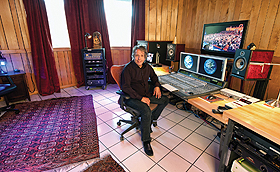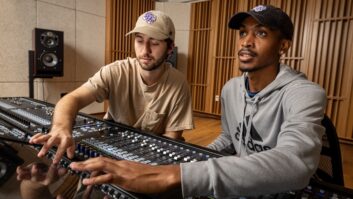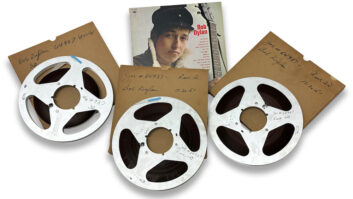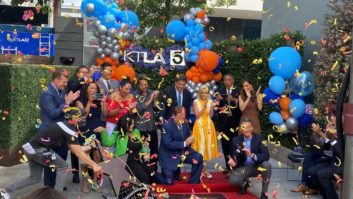
Photo: Steve Jennings
When we last spoke, you had just opened for business inside Bay Area Sound Studios (San Rafael, Calif.), but you’ve moved since then. Could you catch us up on what changed at BASS and what you’re doing now?
I moved out of BASS in July 2010 after a two- and-a-half-year stint. The new owners, TRI, are undergoing an ambitious expansion into HD video Internet broadcast and a 7.1 control room. Our parting was all very friendly, and I’m sure I’ll be back there to mix at some point. I had three-month notice and began the search for a new location. I had several discussions with facilities, but the most intriguing offers came from Studio Trilogy in S.F., a beautifully built multiroom facility—SSL K Series, API and ICON—and Mark Keller’s Loudville in Sausalito, a progressive hybrid recording/ HD video production house with robotic cameras, stage lighting and a D-Command set up in one big soundstage—amazing for live music broadcast and recording in general. I’m sure to be continuing collaborations with both facilities in the future.
How did you end up at The Site?
Richard Mithun, owner of The Site, called, and said, “Before you go get married to somebody else, why don’t you come up here and let’s talk.” I hadn’t really considered The Site; it seemed kind of untouchable. However, I’ve made two albums there, have been a friend of RJ’s for 30 years and the space is inspirational, and the pool outside my control room back door didn’t hurt, either. It was an offer I couldn’t say no to.
For 25 years, The Site was run on its exclusivity factor. Everyone recorded here—Limp Bizkit, Neil Young, Bonnie Raitt, Metallica, Ronstadt, Pearl Jam, Sinatra, Keith Richards—but you had to know the telephone number. It wasn’t listed. Now, we’re reshaping the business model and moving the facility into a new era, continuing with the type of clients the studio traditionally served but with a new presence and accessibility to the local music community.
I heard you built a new control room there.
The studio as a whole is quite large, and it had three iso booths. One of them was in excess of 500 square feet, and that’s the one we converted. It is a tunable room with many acoustic options available. I believe George Massenburg mixed a Grammy-winning [Linda] Ronstadt album in that space, so it has a built-in legacy.
Did you bring in your Pro Tools rig and everything else from BASS?
I brought in an entire studio’s worth of equipment, though I’ve reshaped it a little. I fell in love with Focal speakers, twin subs; added a Lexicon 480L and some additional mic pre’s, Aphex remote and GML; and upgraded the C24’s monitor path to Benchmark DAC1 converters. I have my own wiring and my own headphone system feeding into the live room. I’m in an all-digital world, but don’t think for one moment I’m ignoring one of the world’s greatest Neves [a 72-input 8078], which is in the main control room. It’s the best of both worlds: a fully loaded [in-the-box] Pro Tools system, and in the room next door is the Neve, a mic collection that few can compete with, loads of GML equipment, and both control rooms are wired to the massive live room with 30-foot ceilings.
This sharing of existing spaces combines old and new studio business models. You’re an owner/operator, but you’re putting in with an established business.
Yes. It’s important to keep in mind that the key to the gypsy studio-owner life that I’ve evolved into is to find spaces that are already built out or semi-built out. To lease a warehouse, or house and build out as an individual is cost-prohibitive, but so many people have built out spaces that are sitting dormant now.
I’m hoping a trend is beginning toward people getting out of their home studio micro-worlds. I don’t know if it’s a tangible trend yet, but I would predict that recording production work will head back to a more collaborative environment, and that goes hand-in-hand with people realizing they need good-sounding rooms. Everything can’t be done in your bedroom or your closet, and more than that, who wants to endlessly work alone with no feedback? But the economic reality to this is that people can’t afford those spaces alone, so partnerships like mine are becoming more common.
As a Recording Academy trustee, what are you focusing on locally and nationally?
In San Francisco, one of the primary goals is advocating for our local music scene. We need to stand up for our music venues that have been taking a beating in the press and through overzealous regulation. We’re hosting a San Francisco Supervisor Candidates Forum this month to inform our elected officials that this region is the fourth biggest music market in the country and something we should build upon proactively.
As a national effort, we’re active in advocating the Performance Rights Act. Our Chapter is particularly vocal in that. Professional development is important to our membership and we continue to expand in that area. We’ve launched a cool new Website, grammy365.com, which offers members-only access to some of the country’s most prolific producers, engineers, artists et cetera—whoever is a member. Overall, [it offers] increased content and networking. It’s a good direction.
Find out more about Stephen Hart and The Site at hartmixer.com or thesiterecording.com.







